Kachori is a beloved savory Indian food with a crispy, flaky jacket of wheat wrapping a savory, spicy filling of moong dal. This homemade version make the perfect snack for a cold evening with a cup of hot tea. A vegan, soy-free and nut-free recipe.

It's hard to translate the Hindi word "khasta," often associated with savory Indian snacks, unless you use a combination of terms like, "crispy, crackly, flaky, brittle." But even then, they come short.
If you really want to know what "khasta" tastes and feels and sounds like, you should try a kachori.
Kachoris were popularized around India by the Marwaris, traders from the western Indian state of Rajasthan, who settled across the length and breadth of the country, bringing with them delicious, if often rich and indulgent, foods.
Growing up in diverse Bombay I had a handful of Marwari friends and acquaintances at school and in the neighborhood. But it was while living in Pune for a year that I really learned so much more about the people and food of Marwar. I don't know much about Pune anymore, but back in those days Marwaris, who had lived in the city for generations and ran many of the businesses there, had assimilated easily and effortlessly with the native population. As a result, their foods, like kachori, had also become part of the city's foodscape.
It is easy to see why. This tasty, pot-bellied snack is the best kind of eats there is. Think samosa, but different, and differently delicious.
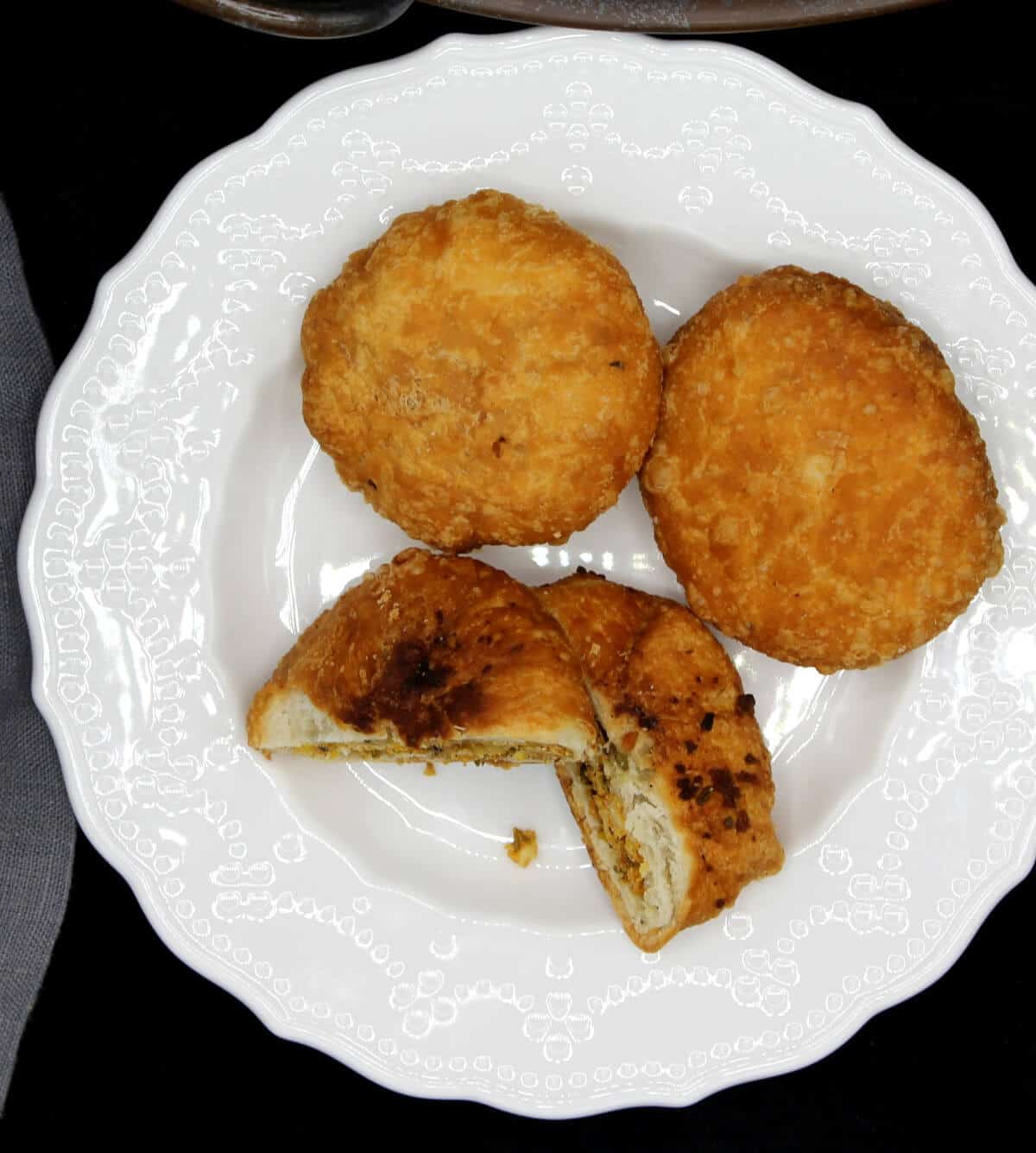
There are many kinds of kachoris, but this Moong Dal Kachori is the one that's most familiar and easily found across India. Jay loves 'em and is often after me to make them. I try and keep things as healthy as possible around here so I don't always oblige, but how can one resist such deliciousness all the time? And kachoris, although deep-fried, offer some healthy elements, like that incredibly lovely filling of moong dal.
My philosophy with homemade deep-fried foods is to make them occasionally and eat in moderation. If you feel the same way, put these on your list for your next indulgence. You'll be back for more, I promise.
What we love about these kachoris
- They're khasta--I just told you what that means. 😉
- They have that incredibly delicious filling of mung beans or moong dal with spices like fennel and cayenne.
- They are pretty easy to make. You do have to go through a few steps like making the dough, making the filling, and putting them together, but if you have ever made parathas or samosas -- or even if you haven't -- you have nothing to worry about. You've got this.
- They're fried, yes, but they are quite light and not sit-in-your-tummy-for-hours heavy. The danger with that, of course, is you could be tempted to eat more, but, ah well.
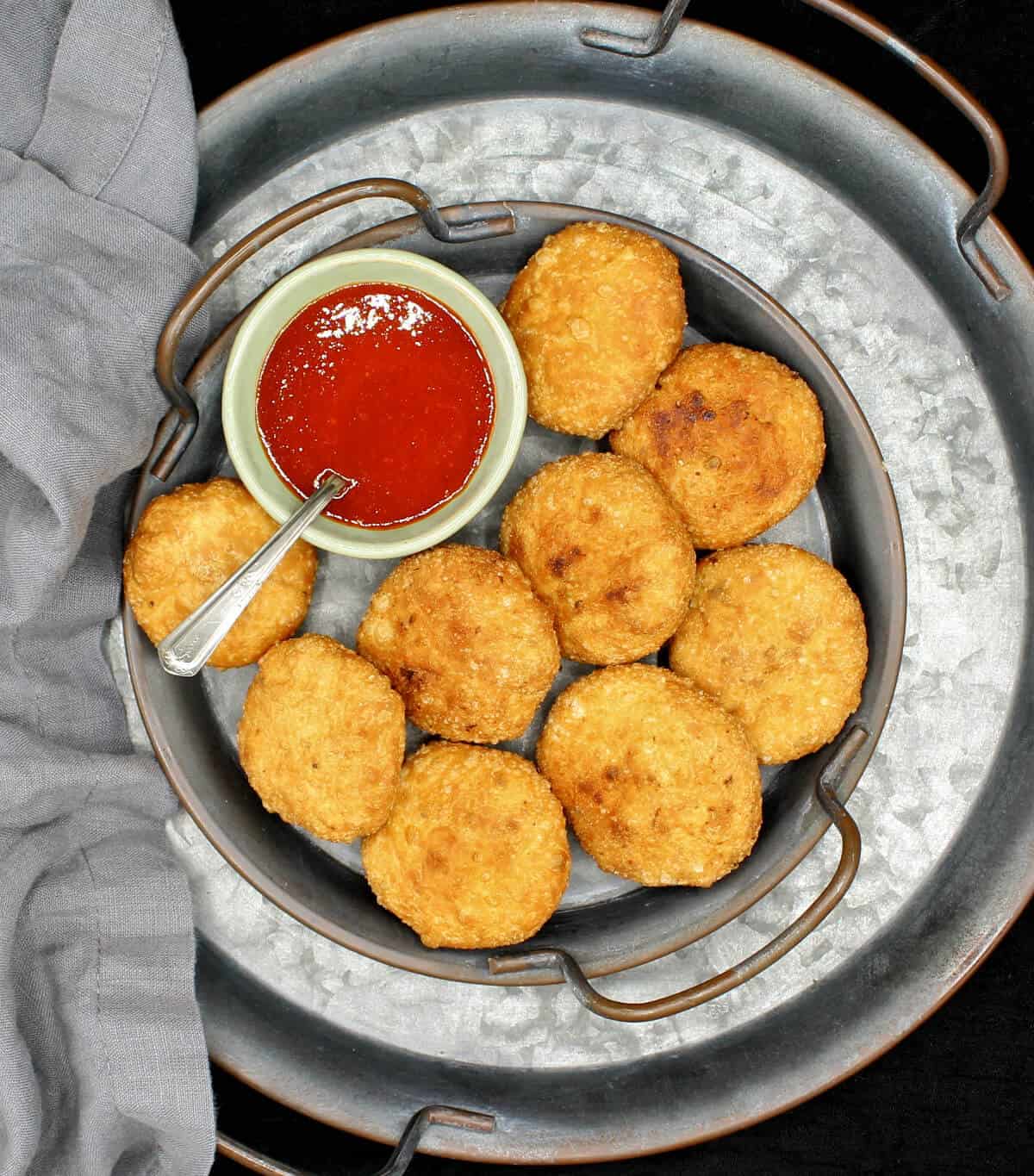
Tips for making kachori
You will need maida for this recipe, a kind of flour used for pastries in India. Maida has a lower protein content than all purpose flour and therefore less gluten, which makes it perfect for foods like samosas and kachoris that should be flaky and crispy. Think of it more as cake flour than all purpose flour. You can find maida at the Indian grocery store or online quite easily if you live here in the United States or anywhere outside India. At a pinch, sub with all purpose flour; your recipe will be delicious but not as khasta.
Ghee is usually added to the maida flour when it is kneaded, to create that flakiness. As ghee is not an ingredient we use hereabouts, I use coconut oil in the kachori dough. Coconut is not a flavor you'd typically find in Rajasthani food, and you know how persnickety I get about staying with the true flavors of regional cooking, but here it disappears into the other, bold flavorings so you won't taste it, especially after you fry the kachori in peanut oil or any other kind of oil. Use oil that's solid at room temperature--put it in the refrigerator for a bit if its liquid--and once it's ready, rub it into the flour to make the flour grainy, then add water and knead.
The dough needs to be kneaded until smooth and it should be soft and pliable but not sticky. Set it aside for about 30 minutes before making the kachori.
You'll need moong dal for this filling. This is the split yellow mung bean without the skin on. Soak the mung for at least two to three hours before you cook it, and, if you have the time, overnight. If soaking for a shorter time, use warm water. You want it to soften as much as possible in the water. Then blitz the dal slightly so it breaks into smaller bits but doesn't become a paste--some of the lentils should remain whole. This helps them cook fast on the stove.
Fennel seed is the most overriding spice in a kachori, and it is gorgeous here. This spice is used commonly used in foods around India, and often offfered as a digestive at the end of a meal, but the Rajasthanis know how to treat it right and give it the dignity it deserves. They mix it into theis sabzis and curries, more so than other Indian cuisines, and it is indispensible in a kachori. In addition to the fennel you'll need coriander seed, dry red chili peppers, cumin seed and turmeric.
Because the mung bean is soaked, there'll be moisture in the filling and you need a binder, so add besan or ground chickpean flour. This also enhances the flavor of the kachori. You will also, of course, need salt for the kachori.
Fry the kachoris at a temperature of between 325 to 350 degrees Fahrenheit. If you don't have a frying thermometer, drop a tiny ball of dough into the oil and it should bubble and float to the top but not brown immediately.
Don't overdry the filling when you cook it. It should be able to hold together in a ball. This is important because you will flatten the kachori after stuffing the dough and forming a ball and a very dry filling will not let you do that.
I included a few photos to show you how to stuff a kachori by pinching the dough into a circle and without a rolling pin, because that's how it's usually done. That said, I would advise you to use a rolling pin, if you have one. That's because when you form the disc with your fingers, unless you're experienced at doing this, you'll probably end up with an uneven, lumpy circle that's lumpy in bits and thin in others. Using a rolling pin is just more likely to guarantee you will get an even circle.
The circle you form should be small, no more than three inches across. Place a ball of the filling inside it and then bring up the sides and gather them at the top. If you have a lot of excess dough, pinch it off. Using the palms of your hands, roll the kachoris until they are smooth and even.
Before frying, place each kachori between your palms and flatten it with slight pressure.
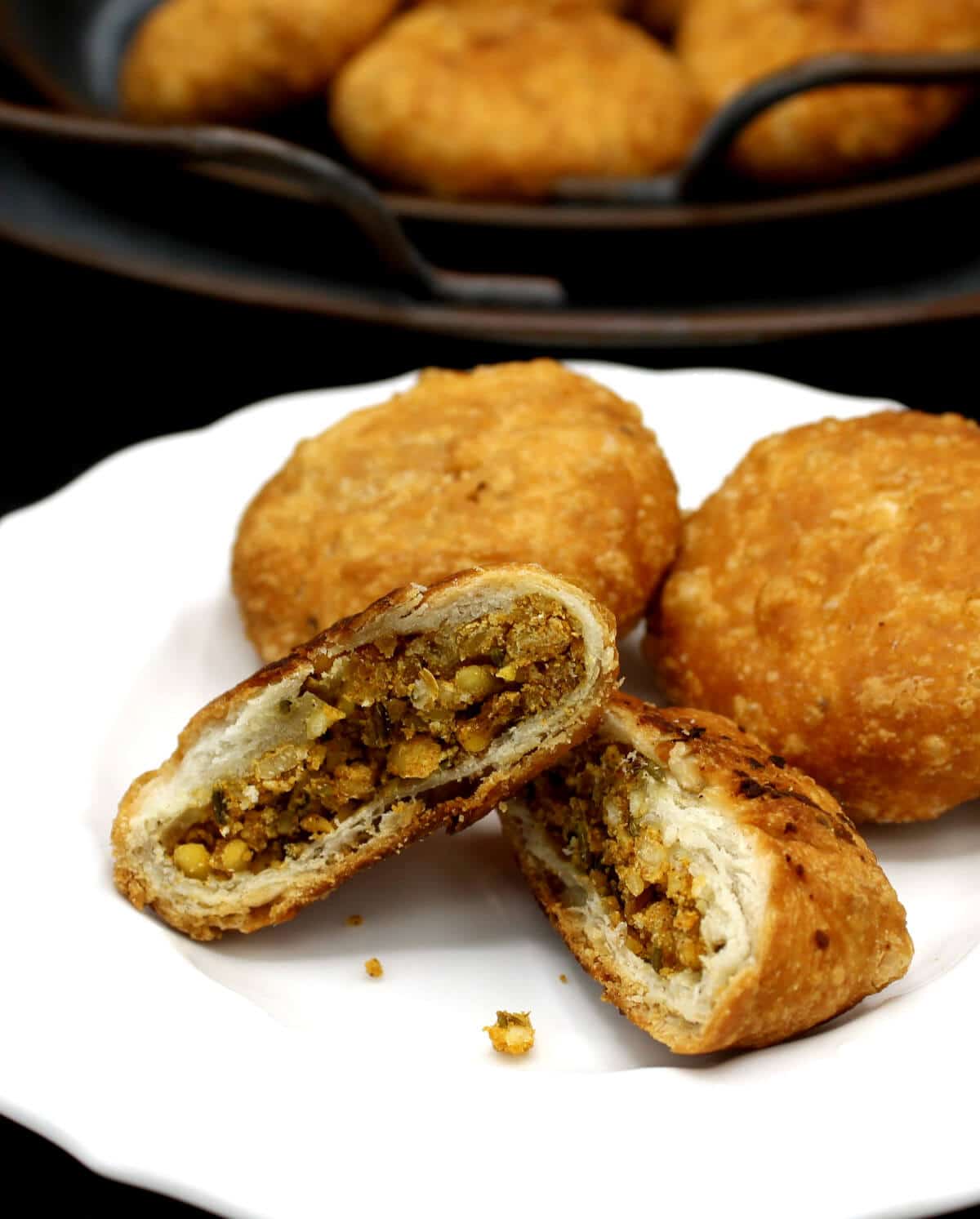
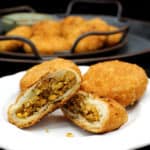
Khasta Kachori recipe
Ingredients
For the kachori dough
- 1 ½ cups maida (an Indian all purpose flour that's low in protein. I've added an affiliate link here, but if you can't find it, use regular all purpose flour)
- ½ tsp salt
- ½ tsp ajwain (caraway seeds)
- 4 tbsp coconut oil (should be solid at room temperature. Refrigerate before using, if it's liquid)
For the stuffing
- ¾ cup moong dal (mung lentils. These are the yellow split moong lentils with no skin, Soak them for 2-3 hours or, preferably, overnight)
- 2 tsp fennel seed
- 1 tbsp coriander seed
- 1 tsp cumin seed
- 2 dry red chili peppers
- 1 tsp vegetable oil
- ½ tsp turmeric
- 1 tsp amchur (mango powder)
- ¼ tsp ginger powder
- ¼ cup besan (chickpea flour)
- Salt to taste
- Peanut oil or other vegetable oil for frying
Instructions
Make the dough
-
Place all the dough ingredients in a bowl. Add water, a little at a time, and knead into a soft, pliable but not sticky dough. Form into a smooth ball, cover and set aside.
Make the stuffing
-
Drain the soaked lentils and grind them coarsely in a food processor. Some lentils should remain whole--it will give the lentil stuffing better texture.
-
In a dry skillet or saucepan, dry roast the fennel, coriander and cumin seeds and dry red chili peppers. Once they start changing color and smell fragrant, turn off the stove and blend them into a coarse powder.
-
In the same skillet or saucepan, heat the vegetable oil. Add the coarsely ground spice blend back to the pan along with the turmeric, amchur and the ginger. Saute for a couple of seconds.
-
Add the besan to the skillet and roast for a couple of minutes to cook the besan a bit and lose the raw flavor. Add the blended mung lentils to the skillet and mix well. Allow the lentils to cook, stirring them frequently, for 3-5 minutes. Add salt as needed. If the mixture looks too dry at this stage, add a tablespoon or two of water. The filling should have no visible moisture but it should be able to hold together in a ball.
-
Make 18 balls with the stuffing when cool enough to handle.
Put the kachoris together
-
Make 18 smooth balls of dough, about an inch in diameter.
-
To form the kachoris, take one of the dough balls. Either pinch the dough with your fingers or, preferably, use a rolling pin, to make a three-inch circle.
-
Place the ball of stuffing inside the circle of dough. Using your pingers, bring the edges over to the top as if you were making a dumpling. Seal the top and pinch off any excess dough.
-
Roll into a smooth ball between the palms of your hands. Flatten each ball into a disc approximately three inches in diameter.
Fry the kachoris
-
Heat enough oil in a frying pan or wok to completely immerse the kachoris. If you have a frying thermometer or candy thermometer, let the oil come up to a temperature of 325 degrees. Otherwise, test the temperature with a small piece of dough. It should drop to the bottom, bubble, and slowly rise.
-
Place three to four kachoris in the oil, depending on the size of your fryer. Don't overcrowd them. Let them cook until golden-brown on one side, then flip and cook the other side.
-
Remove to a colander or dish lined with paper towels. These are delicious cold, but they are best enjoyed hot.
Nutrition
More Savory Indian Snacks
The post Khasta Kachori appeared first on Holy Cow! Vegan Recipes.
from Holy Cow! Vegan Recipes https://ift.tt/2T472G7


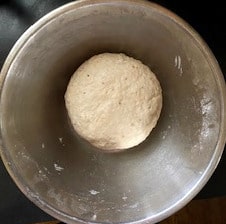
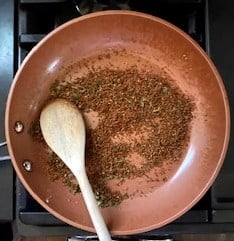
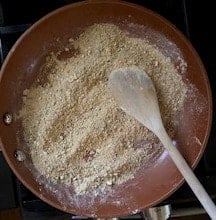
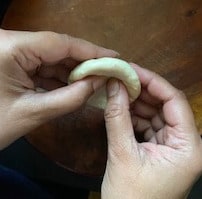
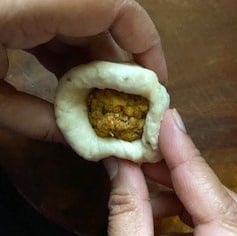
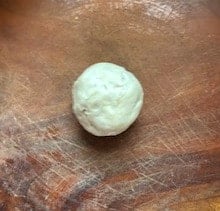


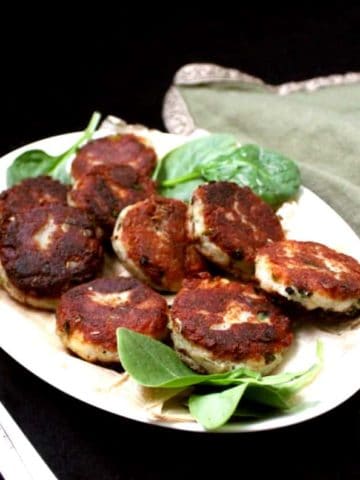
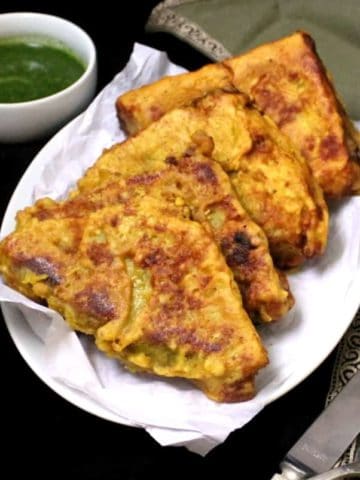





No comments:
Post a Comment